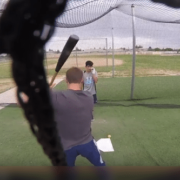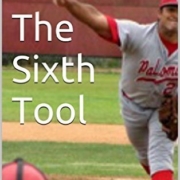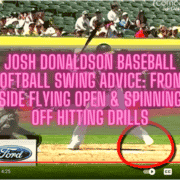How To Maximize A Hitter’s Contribution To Run Scoring Process
How Your Central Hitting “Operating System” May Be Causing You To Lose Out On Scoring More Runs

Photo courtesy: MopUpDuty.com
Recently, I had a conversation with a coach on Facebook who thought the following quote from Josh Donaldson was “horrible advice”:
“If you’re 10-years-old and your coach tells you to get on top of the ball…tell him NO.”
I’m not getting into the positive or negative of Donaldson’s statement, but the coach’s responses that followed his “horrible advice” comment got me thinking. Come to find out, the loud and clear message was this coach despises when hitters strikeout. Often referring to this offensive outcome as “disgusting”. What was interesting was this one principle was central to how and what he teaches his hitters.
So I wanted to do a hitting “operating system” thought experiment. In reading what follows, please keep in mind what the main objective to offense is, according to FanGraphs.com
“In baseball [or softball], we care about run scoring (and prevention) and so when looking at offensive statistics, we want to find statistics that tell you something about how much a player contributes to the run scoring process…again, we care about a player’s contribution to run scoring and if you treat everything equally you’re not getting a very accurate measure of those contributions.”
In this thought experiment, we’ll discuss…as a hitting instructor, what would happen if:
- The Time To Impact Metric was Central to the “Operating System”?
- Minimizing a Hitter’s Strikeouts were Central to the “Operating System”?
- Maximizing Batting Average were Central to the “Operating System”? And,
- Maximizing OPS were Central to the “Operating System”?
Now, that being said…as a hitting instructor, what would happen if…
The Time To Impact Metric was Central to the “Operating System”?
If you’re new to this term, here’s the definition of Time To Impact according to Zepp:
“TIME TO IMPACT is the amount of time (in seconds) from the start of the downswing until impact of the bat with the ball. The closer to ZERO your swing is, the quicker your bat is to the ball. The faster the time to impact, the longer the hitter can wait to start the swing. Time to Impact also measures how short a player’s swing is. Time to Impact measures their coordination of both their hand and the bat barrel to maximize swing efficiency to the ball.”
CLICK HERE for amateur, High School, and Pro ranges for both baseball and softball. What would be the top 2-3 priority hitting concepts guided by this principle?
- Point-A to B barrel path (shortest distance between two points). Default hitting strategy would be “Knob to the ball”. “Swing down”. “Barrel above the hands”.
- Most likely using more linear elements in the swing for both upper and lower half (i.e. ‘showing numbers’ will be a no-no). Maybe similar to a Charlie Lau style of hitting.
- Minimalist view of the swing…wide feet, no stride, minimal hand and head movement, etc. May not believe a hitter can train timing, so the view is that it’s all about bettering the hitter’s reaction time.
Look, there’s a healthy range for Time To Impact, not taking too long, and not being so quick the barrel is not in the impact zone long enough. You can see that range in the previous Zepp link. Remember, we want to formulate hitting principles that encourage how to maximize a player’s contribution to the run scoring process.
Moving on,
As a hitting instructor, what would happen if…
Minimizing a Hitter’s Strikeouts were Central to the “Operating System”?
What if you despised hitters striking out so much, you often referred to this outcome as “disgusting”, like our coaching friend above. What would be the top 2-3 priority concepts guided by this principle?
- Protecting hitters from swing and misses at all cost. Very defensive just make contact swings, especially with 2-strikes. May subscribe to barrel on plane of pitch early and stay on plane longer. Less margin for error.
- Believes in hitting ball hard and on a line. However, low liners and ground-balls are preferred, especially with 2-strikes. Don’t care as much about extra base hits, doubles maybe, but not homers. They aren’t worth the risk. Swings taught at the advent of astro turf fit this type of hitting perfectly. Hard and on the ground.
- Mechanics may look like: wide no-stride feet, bug squishing, minimal head movement from start of swing to finish, choking up (especially with two strikes). Very defensive type of swing. On board with boosting Ball Exit Speeds, but will not agree with optimizing Launch Angles. Besides hitter strikeouts, this coach absolutely hates getting the ball in the air (too much of an out risk for them), unless it’s a low level line drive. High batting average and low strikeouts are very important to this coach.
Listen, if this is you, I’d highly advise checking out this VERY popular post titled, “The UGLY Truth About Hitting Ground Balls”. I’m not going into every argument here, but the math and geometry don’t lie in demonstrating ground-balls are gross. The main reasons are:
- Ask any pitcher, and most (if not all) will tell you they’re taught to keep the ball down in the zone, to get the ground-ball. So, if the default strategy – or safety net to the line-drive – is to hit ground-balls, then you’re teaching hitters to do what pitchers want them to do.
- Because of reason #1, there are 5 fielders on the infield (yes, the pitcher is considered a fielder) with less space to cover. There are only 3 outfielders with A LOT of space to cover. And lastly,
- Most double plays are turned on the infield (probably THE WORST hitting outcome in the sport), and if you’re pinning hopes and dreams on an infielder making an error or ball taking a weird bounce, then you’re focusing on things you can’t control. High level coaches and players don’t think that way. WHY? Because it’s silly.
Again, we want to formulate hitting principles that encourage how to maximize a player’s contribution to the run scoring process. A defensive swing doesn’t do this.
Next, as a hitting instructor, what would happen if…
Maximizing Batting Average were Central to the “Operating System”?
In Golf, precision is key. The least strokes possible. Being able to control the club head has a lot of value because one small deviation at impact is exponentially compounded hundreds of yards from the tee box. The last hitter to hit .400 was Ted Williams in 1941. Tony Gwynn came close in the strike shortened year of 1994, hitting .394, and hitting around .370 in three separate full seasons. And Gwynn had a mere fraction of the power Williams did.
Before I get to what a hitting coach would focus on here, I wanted to address the elephant in the room. In the day and age of Sabermetrics, Batting Average isn’t a useful statistic in deciding a player’s value. In a FanGraphs post titled, “Stats to Avoid: Batting Average”, they put forth two reasons to avoid looking at BA as a useful metric:
- “Batting average ignores a segment of offensive actions just because they aren’t “hits,” and 100 years ago, someone decided a hit and a walk were fundamentally different.” And,
- “The second major flaw is that batting average treats every hit equally even though certain hits are more valuable than others. Batting average treats a single and a double like the same thing, even though a hitter who only hit doubles would help his team score a lot more runs than a hitter who only hit singles.”
That being said, maybe a better stat would be Batting Average on Balls in Play (BABIP). Not the best, but better than BA. FanGraphs.com defines BABIP as:
“Batting Average on Balls In Play (BABIP) measures how often a ball in play goes for a hit. A ball is “in play” when the plate appearance ends in something other than a strikeout, walk, hit batter, catcher’s interference, sacrifice bunt, or home run.”
Okay, so what would be the top 2-3 priority concepts guided by this principle?
- Getting on the plane of the pitch early with the barrel, and maximizing that time.
- Place a high emphasis on barrel control, both horizontally (across the field) and vertically (optimizing Launch Angles). The best hitters in the world can put the ball where they want, when they want, during batting practice.
- This Joey Votto interview post describes this approach, it’s titled, “Joey Votto: Why Coaches SHOULD NOT Be Obsessed With Launch Angles”
I LOVE this approach, and I feel coaches have done a poor job of training their hitters in it in the past (including me). Teaching hitters to hit the ball where they want, when they want. Why can’t we have hitters in High School batting .600 to .800? Or Little Leaguers hitting .880? I know it can be done because I did it when I was 12yo, in addition to hitting 30+ homers. Using Batting Average (BA), or better yet Batting Average on Balls in Play (BABIP), is a great start to encourage how to maximize a player’s contribution to the run scoring process.
The challenge I have with it though, neither of the BA or BABIP metrics take walks and/or homers into account. Remember “contribute to run scoring process”. Which leads me to, as a hitting instructor, what would happen if…
Maximizing OPS were Central to the “Operating System”?
Have you read the book MoneyBall by Michael Lewis, or watched the movie with Brad Pitt? If you haven’t…THEN WHAT’S WRONG WITH YOU!!!! lol, kidding. OPS stands for On-Base Percentage PLUS Slugging Percentage. There are better metrics, but this is a good one to start with if this is new to you. FanGraphs.com defines it as:
“On-base Plus Slugging (OPS) is exactly what it sounds like: the sum of a player’s on-base percentage and their slugging percentage. Many sabermetricians don’t like OPS because it treats OBP as equal in value with SLG, while OBP is roughly twice as important as SLG in terms of its effect on run scoring (x1.8 to be exact). However, OPS has value as a metric because it is accepted and used more widely than other, more accurate statistics while also being a relatively accurate representations of offense.”
It’s one of the best metrics to formulate hitting principles that encourage how to maximize a player’s contribution to the run scoring process. On-Base Percentage (OBP) measures how often a player gets on base. And Slugging Percentage (Slug%) measures how many extra base hits a hitter hits. ISO, or Isolated Slugging (aka “raw power”, takes singles out of the equation), is better than Slug%, but I don’t want to complicate matters. Remember, the object of this game is to get runners on, and knock’em in.
Okay, so what would be the top 2-3 priority concepts guided by this principle?
- High frequency of hitting the ball hard. Increase Ball Exit Speed, or how fast the ball comes off the bat. However high Ball Exit Speeds with low Launch Angles are no good. A few years ago Giancarlo Stanton hit a ball 123.8-mph…on the ground, one-hopper to the second baseman…double play. Ouch.
- Optimize launch angle range between 15 to 25 degrees. This is the ideal line drive range, and optimizes batted ball distance. Some hate talking about Launch Angles, but every batted ball has a launch angle, even bunts.
- Mechanics that optimize both of these are key. How do we optimize Ball Exit Speeds? (Hint: that’s what Power Hitter 2.0: Engineering The Alpha does). What mechanics optimize Launch Angles and hitting more line drives? (Hint: that’s what The Pitch-Plane Dominator does). And importantly, my hitters don’t sacrifice swing quality for power. We get both! My hitters lower their strikeouts, mis-hits, fly-balls, and gross ground-balls with these online video courses.
I think there’s success on whatever part of the spectrum coaches find themselves on. However, what if you lived on a planet that used forks and knives to eat soup? What would happen if an alien came down and surprised them with a spoon? Teaching hitting is the same. There may be thousands of ways to teach hitters, but one way is most effective. What is that way? Applying human movement principles validated by REAL science, NOT “because-I-said-so ‘bro-science'”, to hitting a ball. Have a higher standard for your hitters.
We as coaches have to reverse engineer the our swing strategy based on what the game values, which are runs! The more runs your team can score (and prevent), the more WINS you get. Don’t lose sight of that coaches.
- Fix Late Swings Fast: 2025 Pitch Recognition & See-Decide-Swing Training for Youth Baseball Power Hitters - October 6, 2025
- Safe Youth Weighted Bat Training: Proven Overload/Underload Drills to Increase Exit Velocity in Games Starting Tonight - September 29, 2025
- AI Coaching Course 2025: Youth Baseball & Softball Practice Plan + Off-Season & In-Season Workout Builder Fast - September 23, 2025












Here is the real issue. Who cares about how many runs are scored in any game other than the coaches? Sure the players want to win, but It does not matter one bit. No college recruiter or MLB scout ever asked, “What was your select ball, travel team’s or college team’s record?” Professional coaches want to win to protect their income. All coaches do at the lower levels is player development. You win some, you lose some. You goal is to leave them better than you found them. Donaldson was absolutely correct.
Totally correct. And I agree. However, quite a few coaches out there are IN LOVE with hitting ground-balls. And if that’s their strategy, those poor hitters will not be hitting for extra bases, most likely not getting on base that often, and as a result, won’t be scoring a lot of runs. Losses will be the normal. Without an effective process, we don’t get a great performance.
Great stuff!
Thanks Uncle Flash!
I have been using a DK sensor since Dec 1st with my HS team. A class 5A team in Oklahoma. Everyday the focus was to obtain a consistent launch angle between 10 and 20 degrees positive. I do not talk about strike outs to the group or even two strike hitting. Looking at our states 10 games into the season, and we are 10 and 0, the ratio is about 2-1 walks to strike outs. We have hit 6 HRs, 26 doubles, 8 tripples. We have scored 119 runs. We have played some cream puffs as everyone does, but we have played 4 quality ball clubs with good pitching. The one thing I talk about to the guys is not necessarily try to hit balls in the air, but just to stay through balls and compress them, and hit the ball hard. The launch angles are being controlled by the body spine angles and they naturally take care of themselves and the ball flies. So yes I do agree with Donaldson, and I think its absurd that coaches teach their hitters to swing down and limit the movement of their hitters. No stride and swing down to the ball. Im pretty sure that is not a very good formula for future success of any hitter, unless he may run a sub 6.5 second 60. Just saying……have a good day
Coach DeLong
Great job Coach!! Keep up the fantastic work 😀 Process over performance.
Love the article Joey!!!
What about strategy… Guessing? So we like knowing how to hit a ball… I advocate some type of guessing and observing the pitcher for tells and consistency…
I too HATE strikeouts. I think striking out ought to be embarrassing again but perhaps going out swinging seems like a good thing to many coaches…I think that whenever I’m out, the pitcher got lucky… yea I know they have the advantage but still I’m embarrassed if I strike out, they got lucky if I’m out and I know im at a disadvantage… It doesn’t have to make sense as I know ALL the greats have a weird way of thinking about things… Jerry Rice thought every season he was losing his position, Jordan always found someone to piss himself off…etc…It’s the larger picture that makes sense…
I think on two strikes, we ought to expect a lower end fastball ball down the middle and adjust to it and hit it hard…
I hate choking up… and all the other nonsense… So on two strikes I stop guessing besides getting a strike down the plate which I can adjust too and hit hard… so guessing inside and getting an outside pitch would be two parts away as opposed to down the middle would only means a part adjustment at all times…I’m not sure this makes sense to you… and a slower fast means the fast ball and change are within reason too…
Any thoughts to the my madness???
Anyway… I love the article…Thanks…
~DM
Good Points Djura….I think that most players will have the most success if they just think the middle of the field. That will allow them for the most part, to stay back just enough to hit a change or curve ball and still be able to hit the fast ball. As far as embarrassing strike outs, there is no such thing. If you play the game, you strike out plain and simple. It is frustrating at times for the player, but you never see a major league coach throwing tantrums when his players strike out even in key situations. Only coaches that never played are embarrassed. Just remember, the greatest players in the history of the game have struck out thousands of times…..
Take care….
Coach DeLong
Delong,
There seems to be a contradiction in my thought pattern but a little clarity may help…
I always think the pitcher got lucky when I’m out… Than on the other hand I’m embarrassed of striking out…
So the lucky part is singular… in that at-bat or in this instance….
The strikeouts are an accommodation of strikeouts…
Donnie baseball hit the ball in play and hit it hard… No choking up not nonsense or flares… Hit the ball hard…
Donnie, Ted and others always thought that they would be embarrassed if they striked out 200 times…
So Delong i get your point… if you play baseball you will strike out… You can’t avoid it… You will get out…I agree…
But my point is if you put the work in… Master and OWN your swing ( know everything you possible can know about your swing)….
You will know that if you get out, your opponents got lucky… and if your striking out often you’ll feel embarrassed… Embrassed because you can HIT… and you can HIT hard… and there’s no reason to have a mass of strikeouts…
Said another way… if you think like I do… than it just works out itself…
And if it doesn’t… Than something is missing…
Either you lack confidence… your not putting the work in or you haven’t mastered your swing….
I remember somebody talking about Jeter… He was batting after Jeter… Jeter striked out… He asked Jeter… Did he get you with a change? Jeter replied…a change??? All I know is he was damn lucky… so damn lucky… I want him right now…Ill drill the next pitch for sure… That lucky bitch….
Delong… my overall point is… Hitters are out matched… I would bet that all the good ones think like this…
And I feel if you have a good plan and own your swing you dont strike out a third of the time…
If you hit hard you don’t strikeout ( often)….
If your throwing the bat and Hoping to blast one…you have no control of your swing but a few monster shots may get some ahhhhs… and than we forget what we are doing… which is control the BALL….by a mastered and controlled swing…
Perhaps …
~DM